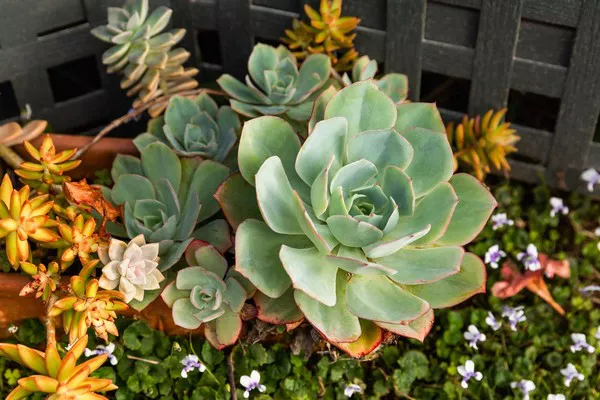Succulent plants have gained immense popularity in recent years due to their unique appearance, easy maintenance, and adaptability to various environments. However, despite their reputation for being low-maintenance, even succulents can face challenges that lead to their demise.
Overwatering and Root Rot
One of the most common causes of succulent plant decline is overwatering. Succulents are adapted to arid environments, so they store water in their leaves and stems. When they receive too much moisture, the roots can rot, which is a condition known as root rot. Symptoms of overwatering include leaves that become soft, translucent, and mushy. The solution to overwatering is to water your succulents sparingly and ensure that the soil dries out completely between waterings. If you suspect root rot, trim away the affected areas and repot your succulent in well-draining soil.
Inadequate Sunlight
Succulents thrive in bright, indirect sunlight or direct sunlight, depending on the species. If your succulent isn’t receiving enough light, it can become weak and leggy as it stretches to reach the light source. Symptoms of inadequate sunlight include pale or elongated growth. To remedy this, place your succulent in a sunnier location, ensuring that it receives at least 6 hours of indirect or direct sunlight daily.
Poor Soil Drainage
Succulents require well-draining soil to prevent water from pooling around the roots. If your succulent is in soil that retains moisture, it can quickly lead to root rot and other issues. Symptoms include wilting, yellowing, and dropping leaves. To address poor soil drainage, repot your succulent in a well-draining succulent mix or amend the existing soil with perlite or sand to improve aeration and drainage.
Inadequate Ventilation
Proper airflow is essential for succulent health. Stagnant air can lead to problems like mold, mildew, and pest infestations. Signs of inadequate ventilation include mold growth on the soil surface or leaves and a general lack of vitality in the plant. To address this issue, ensure that your succulent is placed in a location with good air circulation and consider occasional gentle fan use.
Pest Infestations
Succulents are generally hardy plants, but they are not immune to pest infestations. Common succulent pests include mealybugs, aphids, spider mites, and scale insects. Signs of pest problems include discolored or misshapen leaves, tiny pests on the plant or in the soil, and a generally unhealthy appearance. To combat pest infestations, use insecticidal soap or neem oil to eliminate the pests, and isolate the affected succulent from your other plants to prevent further spread.
Overcrowding and Lack of Space
Succulents need adequate space to grow, and overcrowding in a container can lead to problems. Overcrowded succulents may compete for nutrients and light, resulting in stunted growth and poor health. Signs of overcrowding include restricted root growth, a crowded appearance, and slow growth. The solution is to replant your succulents in individual containers or space them out to provide ample room for growth.
Inadequate Nutrition
Succulents don’t require heavy fertilization, but they do need some nutrients to thrive. If your succulent is suffering from inadequate nutrition, it may exhibit slow growth, pale leaves, or yellowing. To remedy this, use a balanced, diluted liquid succulent fertilizer during the growing season, typically from spring to early autumn, but avoid over-fertilizing, which can harm your succulent.
Environmental Stress
Succulents are sensitive to extreme environmental conditions. Harsh conditions such as temperature extremes, drafts, and sudden changes in lighting can stress your succulent and lead to health issues. Symptoms of environmental stress include wrinkled or discolored leaves. To prevent these problems, maintain consistent environmental conditions and protect your succulent from sudden temperature changes and drafts.
Physical Damage
Accidental physical damage to succulent plants can occur when they are bumped or dropped. Broken or damaged leaves or stems can provide entry points for diseases or pests. To address physical damage, carefully remove damaged parts and allow the plant to callus before replanting or taking cuttings.
Lack of Maintenance
While succulents are known for being low-maintenance, they still require some care. Neglecting your succulent can lead to problems such as dust buildup, which can hinder photosynthesis, and compaction of the soil, which can reduce drainage. Regular maintenance, such as gently wiping the leaves to remove dust and loosening the topsoil to improve aeration, is essential to keep your succulent healthy.
Conclusion
Succulent plants are known for their resilience, but they are not invulnerable to challenges. By recognizing the common issues that can lead to succulent decline and applying the appropriate solutions, you can revive your struggling succulents and prevent future problems. With proper care, attention to environmental conditions, and regular maintenance, you can enjoy a thriving collection of succulent plants that will bring beauty and life to your living space or garden. So, the next time you find yourself asking, “Why is my succulent plant dying?” remember that with the right knowledge and care, you can nurse your succulents back to health and enjoy their unique beauty for years to come.


